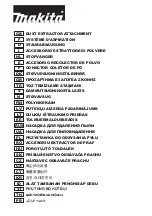
Stud
Die
Punch
Shim
Germany:
HAUPA
, Königstr. 165-169, 42853 Remscheid
Phone: +49 (0)2191 8418-0, Fax: +49 (0)2191 8418-840, [email protected] • Errors and technical changes reserved.
…convincing solutions
english
3
3. OPERATING INSTRUCTIONS
3.1. OPERATION
• This lightweight user-friendly Battery powered Hydraulic Puncher is the best option for both on-site and
factory shop work.
• This tool is a must for all skilled workers specialising in the assembly of aluminium, steel plate or plastic
switching panels, regardless of whether the surface is painted or not.
3.2. TO OPERATE
3.2.1.
Prior drilling.
Use a drill to make an initial Ø 11 mm hole in the plate to be punched.
3.2.2.
Mount the draw studs and spacers
• Mount the M20/10 (pos 39) reducing stud on the tool, screwing it right down to the bottom.
• Locate the spacers (pos 5) on the stud and then mount the die.
• Insert the projecting part of the M10 stud into the hole drilled in the plate.
• Screw the punch into the M10 stud until it comes to a stop against the plate to be punched.
3.2.3.
Punching operation
• Press the operating button and perform the punching operation until you observe that the plate
– swarf has been knocked out.
• Then perform the operations in the reverse order. In other words, press the discharge trigger
(pos 30), unscrew the punch from the stud. The cut piece will easily come out of the die.
3.2.4.
Making holes greater than Ø 31 mm
• Perform the above-mentioned operations until a hole of Ø 20.4 mm minimum has been made.
• Unscrew the M10 stud and the M20/10 reducer
• Screw in the M20 (pos 38) stud until it comes to a stop.
• Insert the spacer on the shaft
• Mount the die on the spacer and insert the rest of the shaft through the Ø 20.4 mm hole.
• Screw the punch onto the M20 stud until it comes to a stop against the sheet metal and then
proceed to punch, as indicated in the points above.
3.2.5.
Making square or rectangular holes
• To make these holes, proceed as for the previous point (point 3.2.4).
drill bit































